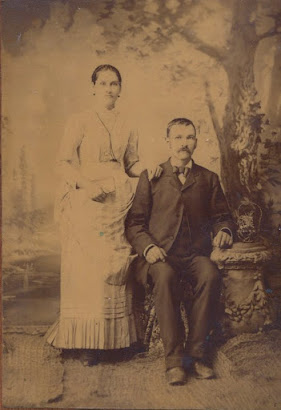Oswald J. Hitz[1] married Sarah J. Harper in December of 1883. While researching Sarah Harper an interesting incident was discovered that involved her father, Manadier D. Harper. The event is known as the Great Hanging of 1862 at Gainesville, Texas.
Rising tensions in Cooke county, Texas were the result of increased migration to the area following an expansion of the Butterfield Overland Mail route, a semi-weekly mail and passenger stage service that traveled from St. Louis, through northern Texas, terminating in San Francisco. The new migrants to the area did not own slaves which caused the numbers of slave owners to dwindle. By 1862 only 10% of the population of Cooke county owned slaves. Cooke and surrounding counties voted against secession which focused the fears of the slave holders in the county on the residents of the county that did not own slaves. A rumor circulated that 1,700 men had joined a Union League and were going to attack Confederate militia arsenals. Due to that rumor, a confederate general ordered the arrest of all able-bodied men who did not report for duty in the Confederate militia.
On October 1, 1862, Texas state troops, led by two Confederate colonels, Bourland and Young, who between them owned almost 25% of all the slaves in the county, arrested 150 men. All those arrested were charged with insurrection or treason and not one of them was a slave owner. The colonels assembled a “Citizen’s Court”, a group of vigilantes, of 12 jurors, 7 of whom were slave owners, to try the arrested men. The court implemented a majority vote condition, requiring only 7 votes to convict instead of 12. This did not bode well for these men.
Seven Unionist leaders were convicted and condemned to hang. Manadier D. Harper was among this first seven. At his trial Harper stated in his defense:
"I was a Union man and desired the restoration of the old government, and I am now grieved to know that my efforts to resist the march of secession have led to results ruinous to the peace and happiness of the community in which I live.
I did not think a desire or an honest effort to reestablish the Union could be termed criminal..."
He was hung on October 4, 1862, 3 days after he was arrested. In an account of the trials and hangings the following was noted:
"Harper was conducted to the place of execution and there in the midst of a multitude of people and a weeping family remained unmoved, and obeying the directions of the executioner in a business-like manner stepped off the carriage..."
This was not an end to the violence. An angry mob lynched 14 more men before the jurors recessed. Another 19 men were convicted and hung on October 19.
After the death of Manadier, his wife Eliza and their six children relocated to Peoria, Illinois. The couple’s first child was born in Illinois so there was a previous connection to the area for Eliza. She supported the family working as a wash woman. Eliza’s daughter, Sarah, married Oswald J. Hitz in Peoria.

References
Barrett, Thomas and Diamond, George Washington (2012). The Great Hanging at Gainesville, 1862, Texas State Historical Association, Denton, Texas.
Bringing in Union Men (2008). Retrieved 2 August 2020, from http://gainesvilletx1862.blogspot.com/2008/06/bringing-in-union-men.html
Great Hanging at Gainesville, The Handbook of Texas Online, Texas State Historical Association (TSHA). (2020). Retrieved 2 August 2020, from https://tshaonline.org/handbook/online/articles/jig01
[1] Oswald Hitz was born Cölestin Hitz in Schneisingen, Aargua, Switzerland. He was the brother of my great-grandmother, Maria Verena (Mary) Hitz Kauffman.

Comments
Post a Comment